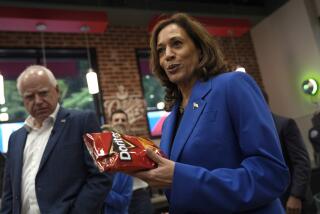Sure, We Can Compete, but Do We Understand the Cost?
- Share via
Eighteen guys already are running for President in 1988, and you can bet that every one of them is going to have a program to make America competitive again. We’ll see five-point, eight-point and ten-point programs, and I’ll listen to all of them as long as the last point is “Here’s what it’s going to cost.”
Any program that skips that last point is hot air, because it is going to cost us a bundle and will require sacrifices from everybody. I’ll also stop listening the minute anyone says that we have to “study” the issue, because the reasons why America has lost its edge are obvious. We don’t need another blue-ribbon commission to tell us; we simply need a blue-ribbon commitment to do something about it. And that means facing up to the costs involved.
The biggest problem is a federal debt that has more than doubled in this decade. The government skims 15 cents off the top of every tax dollar to cover interest payments of more than $150 billion. That’s roughly half a billion dollars a day that’s spent before government paves a single road, buys one missile, feeds a hungry child or does anything to make America more competitive. The problem will not go away until government takes in more revenue and gives us fewer services in return. Sorry, folks, but there’s no other way. We have to ask every candidate how he plans to do that.
Our other big scandal, the trade deficit, won’t be fixed (no matter what else we do) until we stop allowing the United States to be the dumping ground for the world’s excess industrial capacity and put some reciprocity and fairness in our trade rules. The Japanese just “voluntarily” agreed to limit car exports to about $23 billion in 1987. But they also told U.S. construction companies that they couldn’t bid on the new $8-billion Osaka airport because Americans don’t understand Japanese soil conditions. They told our ski manufacturers to keep their skis out of Japan because they don’t understand Japanese snow.
We’ve got to stop outrages like that, but changing the trade rules will almost certainly mean higher consumer prices and even the risk of a little inflation. Are politicians who talk tough about trade willing to accept those costs? Are we?
Recent tax reforms give almost everybody, rich and poor, some kind of break. But they shifted $120 billion of the tax burden onto business and made our companies even less competitive as a result. Our tax system is out of sync with the rest of the world. We tax savings and encourage consumption while everybody else does just the opposite. We don’t give our companies tax advantages for exporting, but everybody else does.
We’re all having a great time joy-riding on cheap gas today while people in Texas are capping wells and our imports of foreign oil are back where they were 15 years ago when the Organization of Petroleum Exporting Countries tightened the noose around our necks. We refuse to learn from history. We won’t write an energy policy that keeps us independent of the cartel. But there’s a price for energy independence. I won’t sell as many high-profit big cars, and consumers will have to pay more at the pump. How many candidates will tell us that we need higher gas prices to protect our competitiveness?
Wall Street has been on a roll lately, but the billions in easy profits have been generated by corporate raiders who have forced U.S. companies to add $200 billion in debt and suck $100 billion out of equity just to survive. Companies have cut back on research and capital spending to maximize short-term profits and ward off raiders. Candidates who are quick to condemn the Ivan Boeskys of Wall Street better be willing to tell us that a lot of those easy paper profits will go away if we put an end to merger mania and pay more attention to being competitive. That’s part of the cost.
One of our biggest problems today is education. Our students aren’t measuring up against kids in Asia and Europe. While our Harvards, MITs and Stanfords are meccas for the best and brightest from all over the world, right across town secondary schools are producing graduates who can’t read, write or count and--you can bet on it--can’t compete.
A country’s competitiveness starts not at the factory or the engineering laboratory but in the classroom. Money alone won’t improve the quality of our schools, but it’s a big part of the solution. The Administration just proposed cutting $5 billion from education at the same time the President said that America had to get more competitive. Candidates always talk about better schools. That’s a motherhood issue. But if they’re serious about giving the next generation a better shot at competing in the world, they have to talk about costs.
During the last two presidential elections we bought the idea of the “Shining City on the Hill.” It was feel-good time. We didn’t want to hear any bad news. We didn’t want to be reminded that we had to pay the light bill for this shining city. If we duck the bad news this time, the lights are going to go out.
With 18 guys now running for President, and all of them talking about “competing,” we’d better be sure that they know what it means--and how much it costs.
More to Read
Inside the business of entertainment
The Wide Shot brings you news, analysis and insights on everything from streaming wars to production — and what it all means for the future.
You may occasionally receive promotional content from the Los Angeles Times.










